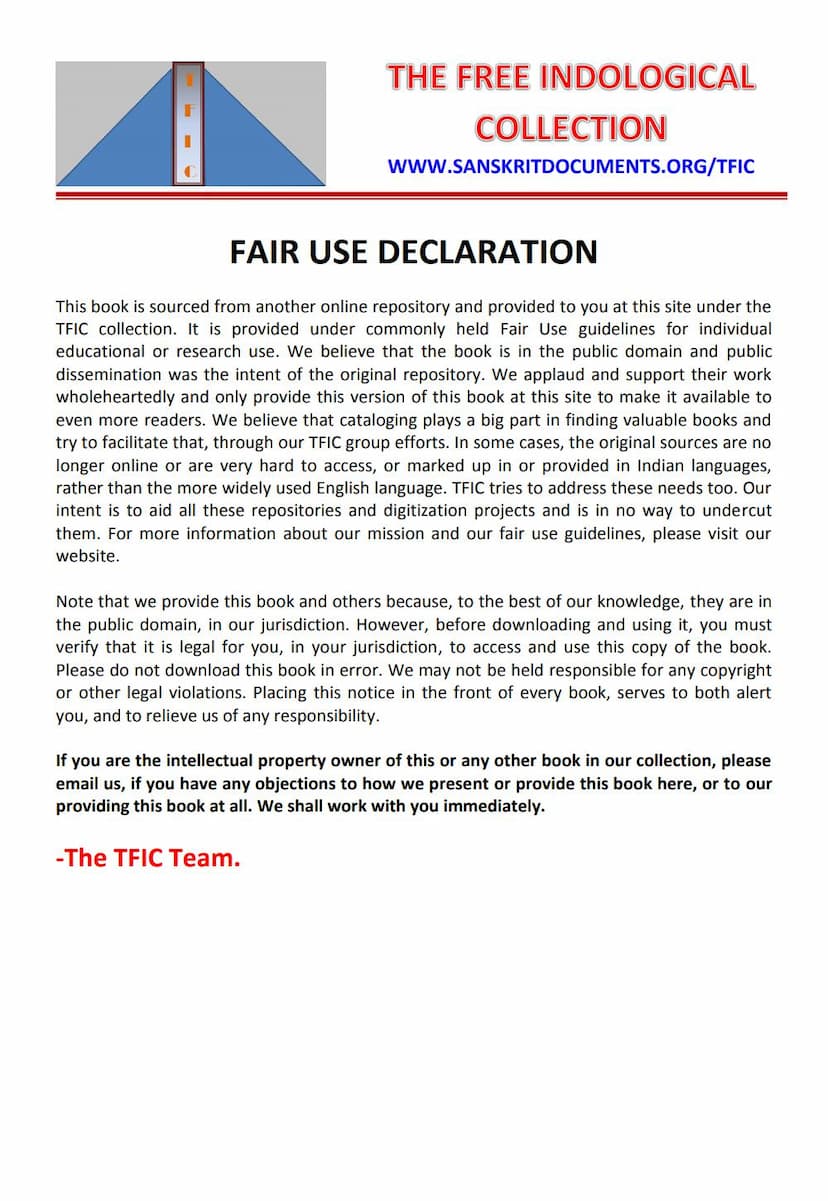Jain Darshan Atma Dravya Vivechanam
Added to library: September 1, 2025

Summary
Here is a comprehensive summary of the Jain text "Jain Darshan Atma Dravya Vivechanam" by M.P. Patairiya:
Overall Purpose and Context:
The book "Jain Darshan Atma Dravya Vivechanam" (The Treatment of Soul in Jain Philosophy) is a doctoral dissertation accepted by Banaras Hindu University, published with the financial assistance of the Ministry of Education, Government of India, in 1973. It aims to provide a detailed and comprehensive exposition of the Jain philosophical understanding of the soul (Atman or Jiva). The work is presented as a significant contribution to Indian philosophical studies, particularly in light of the upcoming 2500th Nirvana Mahotsav of Lord Mahavir.
Key Themes and Structure:
The book is structured thematically, exploring the Jain perspective on the soul through various lenses and comparing it with other Indian philosophical schools. The core themes revolve around:
-
The Nature of Philosophy and Indian Darshanas: The initial chapters establish the foundation by defining the term "Darshan" (philosophy), tracing its origins, and outlining the classification of Indian philosophical systems. It distinguishes between Āstika (orthodox, Vedic) and Nāstika (heterodox) schools, placing Jainism within this framework, while also discussing the antiquity and unique characteristics of Jainism.
-
Jain Cosmology and Ontology (Dravya-Vyavastha): A significant portion of the book delves into the Jain concept of "Dravya" (substance). It explains the Jain metaphysical framework, which posits six fundamental substances: Jiva (soul/life), Pudgala (matter), Dharma (medium of motion), Adharma (medium of rest), Akasha (space), and Kala (time). The book elaborates on the characteristics of each substance, their interrelationships, and the Jain understanding of reality as a combination of attributes and modes (Guna-Paryaya). It highlights the importance of Syādvāda (the doctrine of conditioned predication) and its seven-fold predication (Saptabhangi) as crucial for understanding the manifold nature of reality.
-
The Jain Concept of the Soul (Ātmā/Jīva): This is the central focus. The book meticulously analyzes the origin and meaning of the term "Ātman" (soul) within Jainism. It defines the soul as inherently pure, conscious, and possessing infinite knowledge and perception (Jñāna-Darśana). However, due to the influence of karmas, the soul gets entangled in the cycle of birth and death (Saṃsāra) and experiences various states of existence.
-
The Soul's State in Saṃsāra: The text details the various conditions of the soul in Saṃsāra, including its transmigration through different life forms (from one-sensed beings to celestial beings and hellish beings). It explains the concept of karma and how it binds the soul, leading to different types of bodies and experiences. The book also discusses the causal factors for this bondage, such as delusion (mithyātvā), uncontrolled passions (avirati), negligence (pramāda), vices (kaṣāya), and influx of subtle matter through actions (yoga).
-
The Process of Bondage (Bandha-Prakriyā): A detailed account is given of the mechanism of karmic bondage, the different types of karmas (Jñānāvaraṇa, Darśanāvaraṇa, Vedanīya, Mohanīya, Āyuṣ, Nām, Gotra, Antarāya), and their respective subdivisions. The stages of spiritual development (Guṇasthānas) are explained as a progressive journey towards liberation, illustrating the gradual shedding of karmic impurities.
-
The State of Liberation (Mokṣa) and the Path to it: The book culminates in an exploration of Mokṣa, the ultimate goal in Jainism. It describes Mokṣa not as annihilation but as the soul's attainment of its pure, inherent state of infinite knowledge, perception, bliss, and power, free from all karmic encumbrances. The path to Mokṣa is presented as the "three jewels" (Triratna): Right Faith (Samyak Darśana), Right Knowledge (Samyak Jñāna), and Right Conduct (Samyak Cāritra).
-
Comparative Analysis: Throughout the text, Jain doctrines regarding the soul are systematically compared and contrasted with those of other prominent Indian philosophical schools, including Cārvāka, Buddhism, Nyāya, Vaiśeṣika, Mīmāṁsā, and Sāṅkhya. This comparative approach highlights the unique contributions and perspectives of Jainism.
-
Specific Jain Concepts: The book elaborates on essential Jain concepts like Syādvāda, Anekāntavāda (non-absolutism), Nayas (standpoints), the seven substances (Dravyas), the seven Tattvas (realities), and the fourteen stages of spiritual progress (Guṇasthānas).
Key Arguments and Insights:
- The Soul as an Independent Substance: Jainism posits the soul (Jiva) as an eternal, independent, and conscious substance, distinct from matter and other non-soul substances.
- Karma as the Cause of Bondage: The soul's bondage and suffering are attributed to its association with subtle karmic matter, which adheres to the soul due to its passions and deluded beliefs.
- Liberation through Self-Effort: Liberation is achieved not through divine grace but through the soul's own efforts in purifying itself by destroying the accumulated karma, following the path of Right Faith, Knowledge, and Conduct.
- The Significance of Syādvāda: The doctrine of Syādvāda is presented as the epistemological tool that allows for the understanding of the multifaceted nature of reality and the soul, avoiding dogmatic assertions.
- Jainism's Historical Context: The book emphasizes the ancient origins of Jainism, citing evidence from Vedic and Puranic literature to support its antiquity.
Overall Significance:
"Jain Darshan Atma Dravya Vivechanam" is a scholarly work that provides a rigorous and systematic examination of the Jain concept of the soul. It serves as a valuable resource for scholars and students of Indian philosophy, offering a deep dive into the metaphysical and soteriological aspects of Jainism and its place within the broader landscape of Indian thought. The book's detailed analysis, comparative approach, and comprehensive coverage of Jain doctrines make it an important contribution to the understanding of this ancient Indian tradition.